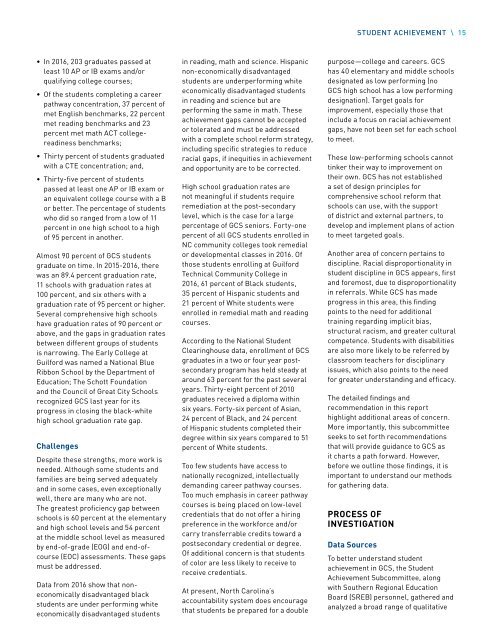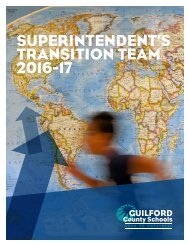Transition Team 2016-17 Final Report
Create successful ePaper yourself
Turn your PDF publications into a flip-book with our unique Google optimized e-Paper software.
STUDENT ACHIEVEMENT \ 15<br />
• In <strong>2016</strong>, 203 graduates passed at<br />
least 10 AP or IB exams and/or<br />
qualifying college courses;<br />
• Of the students completing a career<br />
pathway concentration, 37 percent of<br />
met English benchmarks, 22 percent<br />
met reading benchmarks and 23<br />
percent met math ACT collegereadiness<br />
benchmarks;<br />
• Thirty percent of students graduated<br />
with a CTE concentration; and,<br />
• Thirty-five percent of students<br />
passed at least one AP or IB exam or<br />
an equivalent college course with a B<br />
or better. The percentage of students<br />
who did so ranged from a low of 11<br />
percent in one high school to a high<br />
of 95 percent in another.<br />
Almost 90 percent of GCS students<br />
graduate on time. In 2015-<strong>2016</strong>, there<br />
was an 89.4 percent graduation rate,<br />
11 schools with graduation rates at<br />
100 percent, and six others with a<br />
graduation rate of 95 percent or higher.<br />
Several comprehensive high schools<br />
have graduation rates of 90 percent or<br />
above, and the gaps in graduation rates<br />
between different groups of students<br />
is narrowing. The Early College at<br />
Guilford was named a National Blue<br />
Ribbon School by the Department of<br />
Education; The Schott Foundation<br />
and the Council of Great City Schools<br />
recognized GCS last year for its<br />
progress in closing the black-white<br />
high school graduation rate gap.<br />
Challenges<br />
Despite these strengths, more work is<br />
needed. Although some students and<br />
families are being served adequately<br />
and in some cases, even exceptionally<br />
well, there are many who are not.<br />
The greatest proficiency gap between<br />
schools is 60 percent at the elementary<br />
and high school levels and 54 percent<br />
at the middle school level as measured<br />
by end-of-grade (EOG) and end-ofcourse<br />
(EOC) assessments. These gaps<br />
must be addressed.<br />
Data from <strong>2016</strong> show that noneconomically<br />
disadvantaged black<br />
students are under performing white<br />
economically disadvantaged students<br />
in reading, math and science. Hispanic<br />
non-economically disadvantaged<br />
students are underperforming white<br />
economically disadvantaged students<br />
in reading and science but are<br />
performing the same in math. These<br />
achievement gaps cannot be accepted<br />
or tolerated and must be addressed<br />
with a complete school reform strategy,<br />
including specific strategies to reduce<br />
racial gaps, if inequities in achievement<br />
and opportunity are to be corrected.<br />
High school graduation rates are<br />
not meaningful if students require<br />
remediation at the post-secondary<br />
level, which is the case for a large<br />
percentage of GCS seniors. Forty-one<br />
percent of all GCS students enrolled in<br />
NC community colleges took remedial<br />
or developmental classes in <strong>2016</strong>. Of<br />
those students enrolling at Guilford<br />
Technical Community College in<br />
<strong>2016</strong>, 61 percent of Black students,<br />
35 percent of Hispanic students and<br />
21 percent of White students were<br />
enrolled in remedial math and reading<br />
courses.<br />
According to the National Student<br />
Clearinghouse data, enrollment of GCS<br />
graduates in a two or four year postsecondary<br />
program has held steady at<br />
around 63 percent for the past several<br />
years. Thirty-eight percent of 2010<br />
graduates received a diploma within<br />
six years. Forty-six percent of Asian,<br />
24 percent of Black, and 24 percent<br />
of Hispanic students completed their<br />
degree within six years compared to 51<br />
percent of White students.<br />
Too few students have access to<br />
nationally recognized, intellectually<br />
demanding career pathway courses.<br />
Too much emphasis in career pathway<br />
courses is being placed on low-level<br />
credentials that do not offer a hiring<br />
preference in the workforce and/or<br />
carry transferrable credits toward a<br />
postsecondary credential or degree.<br />
Of additional concern is that students<br />
of color are less likely to receive to<br />
receive credentials.<br />
At present, North Carolina’s<br />
accountability system does encourage<br />
that students be prepared for a double<br />
purpose—college and careers. GCS<br />
has 40 elementary and middle schools<br />
designated as low performing (no<br />
GCS high school has a low performing<br />
designation). Target goals for<br />
improvement, especially those that<br />
include a focus on racial achievement<br />
gaps, have not been set for each school<br />
to meet.<br />
These low-performing schools cannot<br />
tinker their way to improvement on<br />
their own. GCS has not established<br />
a set of design principles for<br />
comprehensive school reform that<br />
schools can use, with the support<br />
of district and external partners, to<br />
develop and implement plans of action<br />
to meet targeted goals.<br />
Another area of concern pertains to<br />
discipline. Racial disproportionality in<br />
student discipline in GCS appears, first<br />
and foremost, due to disproportionality<br />
in referrals. While GCS has made<br />
progress in this area, this finding<br />
points to the need for additional<br />
training regarding implicit bias,<br />
structural racism, and greater cultural<br />
competence. Students with disabilities<br />
are also more likely to be referred by<br />
classroom teachers for disciplinary<br />
issues, which also points to the need<br />
for greater understanding and efficacy.<br />
The detailed findings and<br />
recommendation in this report<br />
highlight additional areas of concern.<br />
More importantly, this subcommittee<br />
seeks to set forth recommendations<br />
that will provide guidance to GCS as<br />
it charts a path forward. However,<br />
before we outline those findings, it is<br />
important to understand our methods<br />
for gathering data.<br />
PROCESS OF<br />
INVESTIGATION<br />
Data Sources<br />
To better understand student<br />
achievement in GCS, the Student<br />
Achievement Subcommittee, along<br />
with Southern Regional Education<br />
Board (SREB) personnel, gathered and<br />
analyzed a broad range of qualitative



